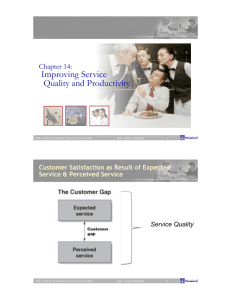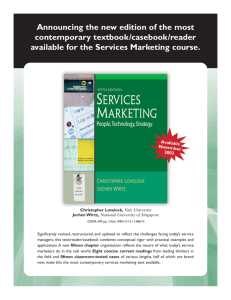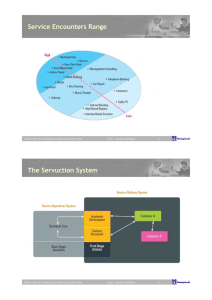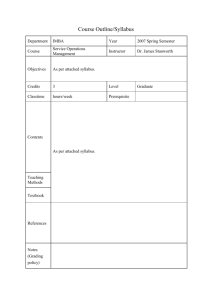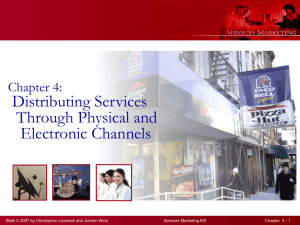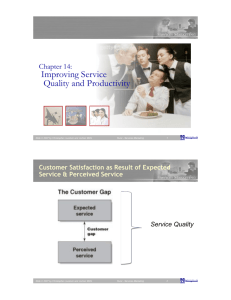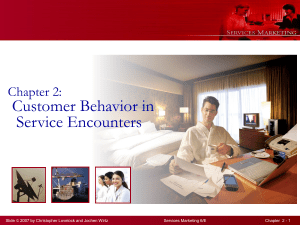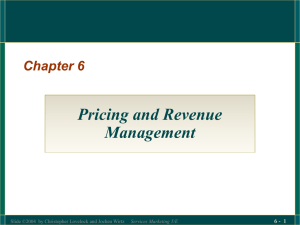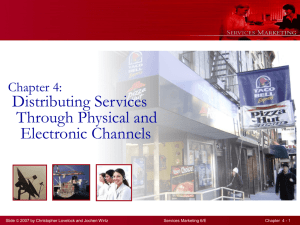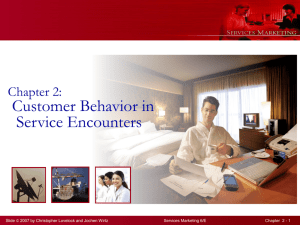Service Marketing Strategies: A Framework Overview
advertisement
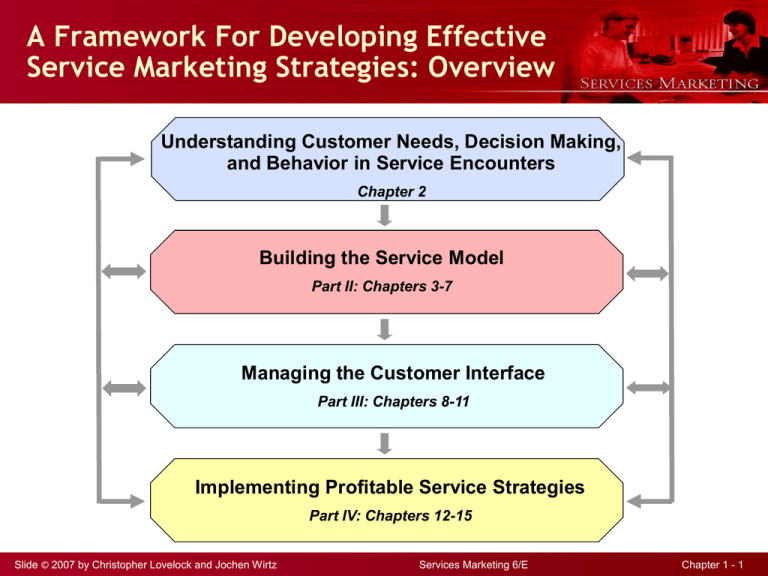
A Framework For Developing Effective Service Marketing Strategies: Overview Understanding Customer Needs, Decision Making, and Behavior in Service Encounters Chapter 2 Building the Service Model Part II: Chapters 3-7 Managing the Customer Interface Part III: Chapters 8-11 Implementing Profitable Service Strategies Part IV: Chapters 12-15 Slide © 2007 by Christopher Lovelock and Jochen Wirtz Services Marketing 6/E Chapter 1 - 1 Framework for Developing Effective Service Marketing Strategies: Part I I: Understanding Customer Needs, Decision Making, and Behavior in Service Encounters (Chapter 2) Differences among Services Affect Customer Behavior Three-Stage Model of Service Consumption Prepurchase Stage: Search, evaluation of alternatives, decision Service Encounter Stage: Role in high-contact vs. low-contact delivery Post-Encounter Stage: Evaluation against expectations, future intentions Slide © 2007 by Christopher Lovelock and Jochen Wirtz Services Marketing 6/E Chapter 1 - 2 Chapter 1: New Perspectives on Marketing in the Service Economy Slide © 2007 by Christopher Lovelock and Jochen Wirtz Services Marketing 6/E Chapter 1 - 3 Overview of Chapter 1 Why Study Services? What are Services? The Marketing Challenges Posed by Services* The Expanded Marketing Mix Required for Services* Integration with Other Management Functions* Slide © 2007 by Christopher Lovelock and Jochen Wirtz Services Marketing 6/E Chapter 1 - 4 Why Study Services? Slide © 2007 by Christopher Lovelock and Jochen Wirtz Services Marketing 6/E Chapter 1 - 5 Why Study Services? (1) Services dominate economy in most nations Understanding services offers you personal competitive advantages Importance of service sector in economy is growing rapidly: Services account for more than 60 percent of GDP worldwide Almost all economies have a substantial service sector Most new employment is provided by services Strongest growth area for marketing Slide © 2007 by Christopher Lovelock and Jochen Wirtz Services Marketing 6/E Chapter 1 - 6 Why Study Services? (2) Most new jobs are generated by services Fastest growth expected in knowledge-based industries Significant training and educational qualifications required, but employees will be more highly compensated Will service jobs lost to lower-cost countries? Yes, some service jobs can be exported Slide © 2007 by Christopher Lovelock and Jochen Wirtz Services Marketing 6/E Chapter 1 - 7 Changing Structure of Employment as Economic Development Evolves Agriculture Services Industry Time, per Capita Income Slide © 2007 by Christopher Lovelock and Jochen Wirtz Source: IMF, 1997 Services Marketing 6/E Chapter 1 - 8 What Are Services? Slide © 2007 by Christopher Lovelock and Jochen Wirtz Services Marketing 6/E Chapter 1 - 9 Defining Services Services Are economic activities offered by one party to another Most commonly employ time-based performances to bring about desired results in: ― recipients themselves ― objects or other assets for which purchasers have responsibility In exchange for their money, time, and effort, service customers expect to obtain value from Access to goods, labor, facilities, environments, professional skills, networks, and systems But they do not normally take ownership of any of the physical elements involved Slide © 2007 by Christopher Lovelock and Jochen Wirtz Services Marketing 6/E Chapter 1 - 10 Service Products versus Customer Service and After-Sales Service A firm’s market offerings are divided into core product elements and supplementary service elements Is everyone in service? Need to distinguish between: Marketing of services Marketing goods through added-value service Good service increases the value of a core physical good Manufacturing firms are reformulating and enhancing existing added-value services to market them as standalone core products Slide © 2007 by Christopher Lovelock and Jochen Wirtz Services Marketing 6/E Chapter 1 - 11 Challenges Posed by Services* Slide © 2007 by Christopher Lovelock and Jochen Wirtz Services Marketing 6/E Chapter 1 - 12 Services Pose Distinctive Marketing Challenges Marketing management tasks in the service sector differ from those in the manufacturing sector The eight common differences are: 1. Most service products cannot be inventoried 2. Intangible elements usually dominate value creation 3. Services are often difficult to visualize and understand 4. Customers may be involved in co-production 5. People may be part of the service experience 6. Operational inputs and outputs tend to vary more widely 7. The time factor often assumes great importance 8. Distribution may take place through nonphysical channels What are marketing implications? Slide © 2007 by Christopher Lovelock and Jochen Wirtz Services Marketing 6/E Chapter 1 - 13 Differences, Implications, and Marketing-Related Tasks (1)* (Table 1.1) Difference Most service products cannot be inventoried Intangible elements usually dominate value creation Services are often difficult to visualize and understand Customers may be involved in coproduction Implications Marketing-Related Tasks Customers may be turned away demand; work with ops to manage capacity Harder to evaluate service and distinguish from competitors Emphasize physical clues, employ metaphors and vivid images in advertising Educate customers on Greater risk and uncertainty perceived Interaction between customer and provider; but poor task execution could affect satisfaction Slide © 2007 by Christopher Lovelock and Jochen Wirtz pricing, promotion, and Use reservations to smooth making good choices; offer guarantees Develop user-friendly equipment, facilities, and systems; train customers, provide good support Services Marketing 6/E Chapter 1 - 14 Differences, Implications, and Marketing-Related Tasks (2)* (Table 1.1) Difference People may be part of service experience Operational inputs and outputs tend to vary more widely Implications Marketing-Related Tasks Behavior of service personnel and customers can affect satisfaction assumes great importance Distribution may take place through nonphysical channels reinforce service concept Shape customer behavior Hard to maintain quality, Redesign for simplicity and Difficult to shield Time is money; Find ways to compete on consistency, reliability customers from failures Time factor often Recruit, train employees to customers want service at convenient times Electronic channels or voice telecommunications Slide © 2007 by Christopher Lovelock and Jochen Wirtz failure proofing Institute good service recovery procedures speed of delivery; offer extended hours Create user-friendly, secure websites and free access by telephone Services Marketing 6/E Chapter 1 - 15 Value Added by Physical, Intangible Elements Helps Distinguish Goods and Services (Fig 1.6) Physical Elements High Salt Detergents CD Player Wine Golf Clubs New Car Tailored clothing Fast-Food Restaurant Low Source; Adapted from Lynn Shostack Slide © 2007 by Christopher Lovelock and Jochen Wirtz Plumbing Repair Health Club Airline Flight Landscape Maintenance Consulting Life Insurance Internet Banking Intangible Elements Services Marketing 6/E High Chapter 1 - 16 Progressive and REI: Two Types of Website Reflecting Core Product (Fig 1.8) Websites can deliver info-based services like Progressive’s car insurance but … …REI’s camping gear must be delivered through physical channels to customers after they have used the website to make choices, order, and pay Slide © 2007 by Christopher Lovelock and Jochen Wirtz Services Marketing 6/E Chapter 1 - 17 Expanded Marketing Mix for Services* Slide © 2007 by Christopher Lovelock and Jochen Wirtz Services Marketing 6/E Chapter 1 - 18 Services Require An Expanded Marketing Mix Marketing can be viewed as: A strategic and competitive thrust pursued by top management A set of functional activities performed by line managers A customer-driven orientation for the entire organization The “8Ps” of services marketing are needed to create viable strategies for meeting customer needs profitably. Slide © 2007 by Christopher Lovelock and Jochen Wirtz Services Marketing 6/E Chapter 1 - 19 The 8Ps of Services Marketing Product Elements (Chapter 3) Place and Time (Chapter 4) Price and Other User Outlays (Chapter 5) Promotion and Education (Chapter 6) Process (Chapter 8)* Physical Environment (Chapter 10)* People (Chapter 11)* Productivity and Quality (Chapter 14)* Fig 1.9 Working in Unison: The 8Ps of Services Marketing Slide © 2007 by Christopher Lovelock and Jochen Wirtz Services Marketing 6/E Chapter 1 - 20 The 8Ps of Services Marketing: (1) Product Elements Embrace all aspects of service performance that create value Core product responds to customer’s primary need Array of supplementary service elements Help customer use core product effectively Add value through useful enhancements Slide © 2007 by Christopher Lovelock and Jochen Wirtz Services Marketing 6/E Chapter 1 - 21 The 8Ps of Services Marketing: (2) Place and Time Delivery decisions: Where, When, How Geographic locations served Service schedules Physical channels Electronic channels Customer control and convenience Channel partners/intermediaries Slide © 2007 by Christopher Lovelock and Jochen Wirtz Services Marketing 6/E Chapter 1 - 22 The 8Ps of Services Marketing: (3) Price and Other User Outlays Customer outlays involve more than price paid to seller Traditional pricing tasks: Selling price, discounts, premiums Margins for intermediaries (if any) Credit terms Identify and minimize other costs incurred by users: Additional monetary costs associated with service usage (e.g., travel to service location, parking, phone, babysitting, etc.) Time expenditures, especially waiting Unwanted mental and physical effort Negative sensory experiences Slide © 2007 by Christopher Lovelock and Jochen Wirtz Services Marketing 6/E Chapter 1 - 23 The 8Ps of Services Marketing: (4) Promotion and Education Informing, educating, persuading, reminding customers Marketing communication tools Media elements (print, broadcast, outdoor, retail, the Internet, etc.) Personal selling, customer service Sales promotion Publicity/PR Imagery and recognition Branding Corporate design Content Information, advice Persuasive messages Customer education/training Slide © 2007 by Christopher Lovelock and Jochen Wirtz Services Marketing 6/E Chapter 1 - 24 The 8Ps of Services Marketing: (5) Process How firm does things may be as important as what it does Customers often actively involved in processes, especially when acting as co-producers of service Process involves choices of method and sequence in service creation and delivery Design of activity flows Number and sequence of actions for customers Nature of customer involvement Role of contact personnel Role of technology, degree of automation Badly designed processes waste time, create poor experiences, and disappoint customers Slide © 2007 by Christopher Lovelock and Jochen Wirtz Services Marketing 6/E Chapter 1 - 25 The 8Ps of Services Marketing: (6) Physical Environment Design servicescape and provide tangible evidence of service performances Create and maintain physical appearances Buildings/landscaping Interior design/furnishings Vehicles/equipment Staff grooming/clothing Sounds and smells Other tangibles Manage physical cues carefully— can have profound impact on customer impressions Slide © 2007 by Christopher Lovelock and Jochen Wirtz Services Marketing 6/E Chapter 1 - 26 The 8Ps of Services Marketing: (7) People Interactions between customers and contact personnel strongly influence customer perceptions of service quality The right customer-contact employees performing tasks well Job design Recruiting Training Motivation The right customers for firm’s mission Contribute positively to experience of other customers Possess needed skills (co-production) Can shape customer roles and manage customer behavior Slide © 2007 by Christopher Lovelock and Jochen Wirtz Services Marketing 6/E Chapter 1 - 27 The 8Ps of Services Marketing: (8) Productivity and Quality* Productivity and quality must work hand in hand Improving productivity key to reducing costs Improving and maintaining quality essential for building customer satisfaction and loyalty Ideally, strategies should be sought to improve both productivity and quality simultaneously—technology often the key Technology-based innovations have potential to create high payoffs But, must be user friendly and deliver valued customer benefits Slide © 2007 by Christopher Lovelock and Jochen Wirtz Services Marketing 6/E Chapter 1 - 28 Marketing Must Be Integrated with Other Management Functions* Slide © 2007 by Christopher Lovelock and Jochen Wirtz Services Marketing 6/E Chapter 1 - 29 Marketing Must Be Integrated with Other Management Functions* (Fig 1.10) Three management functions play central and interrelated roles in meeting needs of service customers Operations Management Marketing Management* Customers Human Resources Management* Slide © 2007 by Christopher Lovelock and Jochen Wirtz Services Marketing 6/E Chapter 1 - 30 A Framework for Developing Effective Service Marketing Strategies (Fig 1.11 on p.28) Slide © 2007 by Christopher Lovelock and Jochen Wirtz Services Marketing 6/E Chapter 1 - 31 Chapter 1 Summary: New Perspectives on Marketing in the Service Economy Reasons for studying services: Service sector dominates economy in most nations, many new industries Most new jobs created by services Powerful forces—government policies, social changes, business trends, IT advances, and globalization—are transforming service markets Understanding services offers personal competitive advantage The service concept and its definition: Services create benefits without transfer of ownership Most employ time-based performances to bring about desired results in recipients or in assets for which they have responsibility Customers expect value from access to goods, facilities, labor, professional skills, environments, networks & systems in return for money, time, effort Services present distinctive marketing challenges relative to goods, requiring: Expanded marketing mix comprising 8Ps instead of traditional 4Ps Integration of marketing function with operations and human resources Slide © 2007 by Christopher Lovelock and Jochen Wirtz Services Marketing 6/E Chapter 1 - 32
